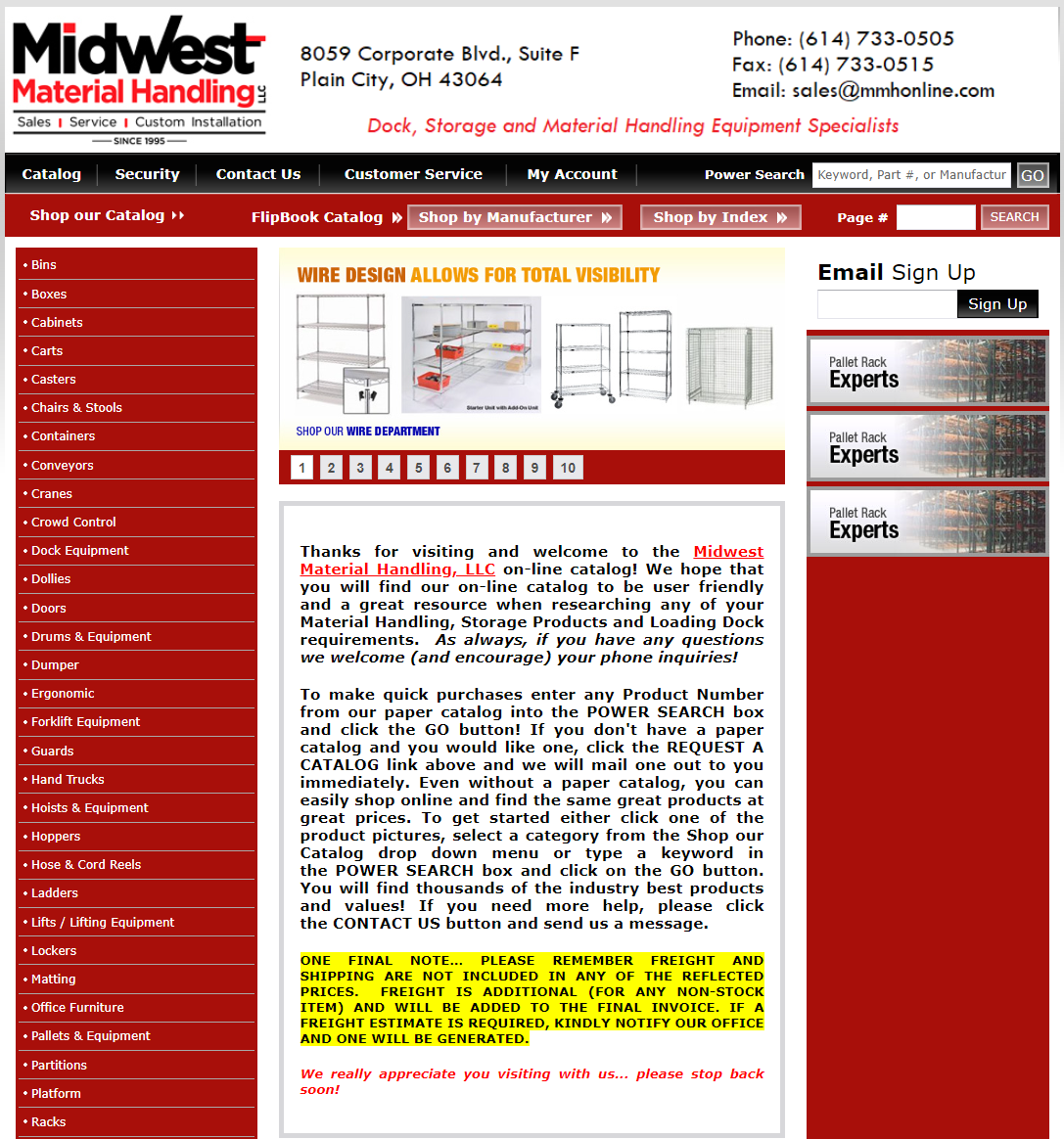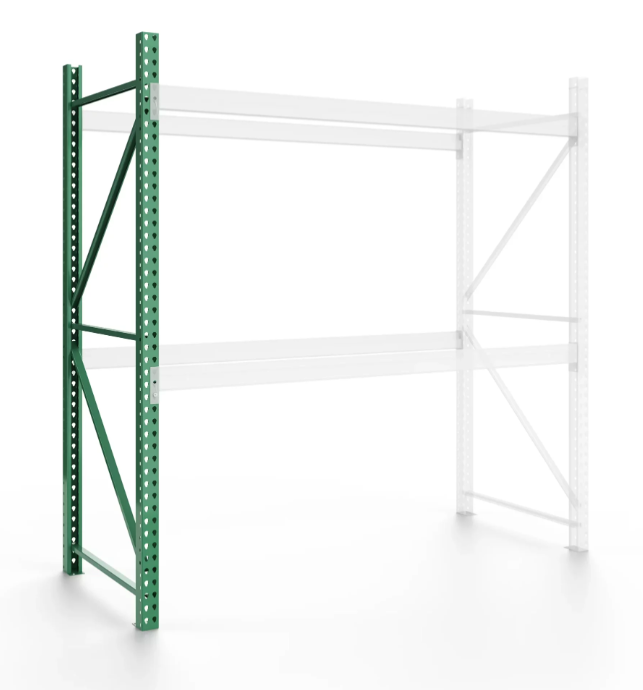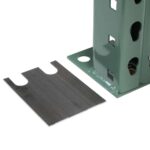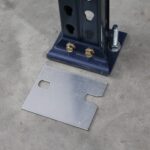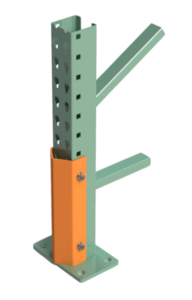Pallet Rack Uprights-Teardrop, Keystone, New and Used. Columbus, Ohio
PALLET RACK UPRIGHTS
Pallet Rack Uprights, like Beams come in a wide range of different heights, depths and capacities. They are constructed in both open and closed (heavier weight capacities) tubular column designs with open style being, by far the most common as they are less expensive. Uprights have traditionally always been fully welded… vertical and horizontal crossmembers have been welded to the Upright columns. Fully welded Uprights have been around for decades, due to their durable and effective design, little has changed. Pallet Rack Uprights also come in a wide range of styles, with Teardrop Style being the most popular and realistically, the only style we sell any more.
UPRIGHT IN-STOCK SIZES
Standard in-stock Upright Heights: 96”, 120”, 144”, 168” and 192” and 240” heights
Standard in-stock Upright Depths: 24”, 36”, 42” and 48” heights
- Standard Upright capacities: from 15,000 to up to 30,000 lbs.
Standard column dimensions are: 3” x 1 5/8”, 3″ x 2.69″ (Interlake-Mecalux Bolted) and 3” x 3”. Upright columns are both open (similar to a “U”) and closed in design. Due to the design of the closed tube Upright, they have greater capacities but are generally more expensive.
Pallet Rack Upright Weight and capacity ratings… how are determined?
One confusing question we get often is relating the the weight ratings on Pallet Rack Uprights. Capacities for all sizes vary from Manufacturer to Manufacturer based on their individual methods of load testing.
For example, one Manufacturer may rate the capacity of a similar 3” x 1 5/8” Upright at 15,600 lbs. and another at a 19,130 lbs. capacity (and others in between). Even though the design may be the same on both, a major factor in these differing capacity ratings is Vertical Beam Spacing. Vertical Beam Spacing (or VBS) is the spacing between Beams or shelves on a rack. Generally, load ratings are determined at a 48″ (which is the size of a standard pallet) VBS. The higher the VBS, the lower the rated capacity. Conversely, the lower the VBS, or the closer together the shelves are, the higher the rated capacity.
One additional difference in the capacity ratings for Uprights is the gauge of the steel and the simple number of “bends” the manufacturer uses in the manufacturing process.
Most manufacturers post a chart of load ratings at different vertical beam spacings. Click here for an example of a Ridg-U-Rak Upright capacity chart (note the significant increased capacities with an additional “bend” or “turn” at the end of each Upright).
Standard Upright depths (front-to-back) are 24”D, 36”D, 42”D and 48”D. Of course, any size (height, depth and capacity) of Upright can be ordered, the drawback is an often times lengthy lead time!
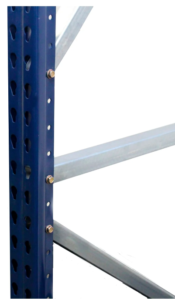
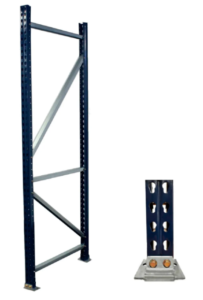
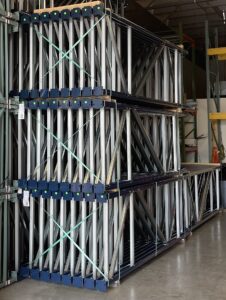
BOLTED Pallet Rack UPRIGHTS
More recently, Interlake-Mecalux has introduced a new “bolted design” which has become quite popular due primarily to cost. These Uprights incorporate the horizontal and vertical cross members (which are constructed of galvanized steel) to be bolted to the roll formed columns. These bolted columns are generally 3″W x 2.69″L. These Uprights are not welded in any way, even the foot assemblies are bolted on (they are constructed of galvanized steel are are larger than a standard foot plate on a welded Upright).
One unique aspect of this design is it allows for the user to easily repair the Upright by simply replacing the single damaged column. From a cost perspective, bolted Uprights are priced similarly to a lower capacity, 3″ x 1 5/8″ column size all-welded Upright.
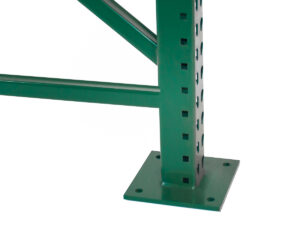
Seismic Pallet Racking Uprights
For our national customers in seismic regions where ground movement occurs (generally in the western U.S., as well as the central area of the midwest including southern Illinois, western Kentucky, western Tennessee, eastern Missouri, eastern Arkansas and globally in the Pacific Rim), we offer a specifically designed seismic Uprights and Beams which takes into account multiple environmental factors when designed to prevent damage during seismic events.
One feature of a seismic Upright is the inclusion an oversized footplate, designed larger and thicker than standard footplates. We provide these seismic footplates many times to Customers in non-seismic areas who just want a larger, thicker footplate for enhanced protection from damage or have unlevel or non flat surfaces.
Steel Shims for Uneven Surfaces
Steel Shims can be provided to install Pallet Rack Uprights on uneven surfaces. It is imperative that Pallet Racking be installed on flat or level surfaces. In applications where the concrete is old, cracked or uneven, steel shims can help.
Shims come in a range of different styles. It is important that you pick the correct pallet rack shim plate to match the brand of upright and size of the footplate. Upright footplates can vary in design, as a result, it is very important to use only factory approved shims, as the are specifically sourced based off of the design of the Uprights.
Depending on the severity of the base, there may be a need to use more than one shim. If that is the case, there are very specific guidelines to follow as to how many are safe and how to secure them in place to prevent shifting.
- Shim stack cannot exceed six times the diameter of the largest anchor bolt.
- Shim stack that is less than two times the anchor’s diameter does not require locking shims together by welding or installing a second anchor.
- Shim stacks between two times but less than six times the diameter of the anchor must be locked by welding or adding a second anchor. If shims are not welded or secured with a second anchor, they can spin out, causing rack instability.
- Shim stacks may require longer anchor bolts.
Pallet Rack Accessories… Post Protectors, Column Guard, End of Aisle Protectors, Row Spacers-Wall Ties & Load Backstop Beams
Contact our sales department for additional information on a wide range of Pallet Rack Accessories designed for increased efficiency, added security of stored products and enhanced stability. The primary function of these items is… INCREASED SAFETY! Let’s talk about some of the more common accessories…
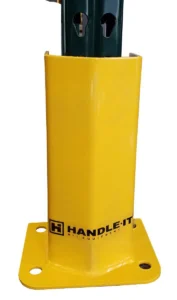
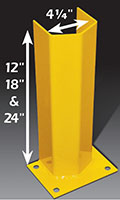
Post Protectors
Protecting your rack fixtures is protecting a large investment. A Post Protector is designed to prevent damage to pallet rack upright columns during loading and removal of pallets. We are often asked “what is the most effective method of protecting my Pallet Rack Uprights from damage?” The answer is relatively simple… the most effective solution to protect front column Uprights from Forklift or Fork Truck damage is a simple 12″-24″ high Steel Post Protector. Standard inside dimension (ID) width sizes from 4.5″-8.5″.
These simple Post Protectors have been around as long as Pallet racking has been on the market. They are the least expensive (generally less than $50 each) but are the most effective protection method available in today’s marketplace!
How are Post Protectors installed?
Post protectors are typically anchored into the flooring directly in front of the upright. Bolt-on pallet rack post protectors are typically attached directly to the rack column and are available in either steel or hardened plastic. These Post Protectors are simply positioned around the front of the Upright column and 4-5 (the exact number of required anchors is dependent on the manufacturer) concrete wedge anchors installed. Generally, we use a commercially available 3.75″-4″ x 0.5″ wedge anchor.
We are happy to supply the anchors or you can purchase yourself. A simple “Screw Anchor” can also be used, reducing the install time (not a big deal for a few anchors but a significant time savings when several hundred are being installed!).
- Heavy duty Steel Post Protectors provide a low-cost method of reducing damage to expensive equipment, product and materials as well as protecting personnel from falling rack structures hit by moving vehicles.
- 5-gauge steel protectors are easily mounted by securing to the concrete floor.
- Post Protectors are painted in safety yellow hard glossy finish for a durable attractive appearance.
Column Guard
Another common and inexpensive method to protect your Pallet Rack Upright columns is a bolt-on Column Guard. These guards differ in design from Post Protectors as they are simply bolted onto the Upright column and are designed to “deflect” fork or skid impact to the Upright. These come in many different styles and designs. They are not anchored to the concrete but instead bolted directly to the Upright in two locations. These are a very common rack accessory… but while these guards can help, in our opinion, they simply do not provide the same level of upright protection as a standard Post Protector.
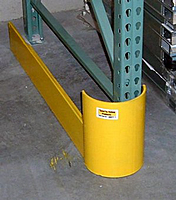
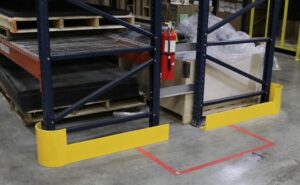
End of Aisle Guard-Protector
End of Aisle Protectors are a superior method for protecting the end of Pallet Rack aisles from forklift or motorized vehicle damage. They “wrap” around the front and rear columns to provide maximum protection. These can be purchased as either “left hand” or “right hand”, based on their installation position and come in a range of different depths based on the Upright depths. These also are designed for common “back-to-back” rack configurations.
- Unit mounts directly to the floor surrounding the upright frame.
- Heavy Duty design has 12″ tall upright with 6″ tall x 4″ wide angle, 1/2″ thick.
- Standard design has 8″ tall upright with 5″ tall x 3″ wide angle, 1/4″ thick.
- Standard lengths are 36″, 42″ or 48″.
- Available in right sides, left sides and doubles.
- Powder coated safety yellow.
- 5/8″ x 4.75″ anchors are available upon request.
Row Spacers, Wall Ties and Steel Cross Bars
The most common Pallet Rack accessories are Steel Row Spacers, Steel Wall Ties and Steel Cross Bars. A bit about each…
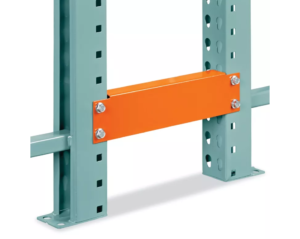
Row Spacer
Are used in back-to-back applications. Row Spacers keep an even and equal spacing from the two back-to-back rack sections. They come in several different lengths, the most common being 6”, 12”, 18” and 24” long. They are furnished with mounting hardware (nuts, washers and bolts) and bolt onto each upright. We recommend a Row Spacer positioned near the top (8”-12”) and another near the bottom (8”-12”). Row Spacers are not only designed to keep back-to-back rack sections properly spaced; an additional benefit is they also provide additional stability to the rack section.
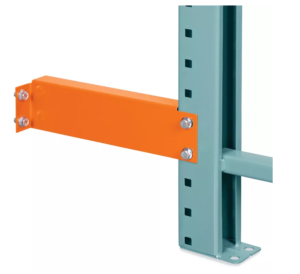
Wall Tie
Wall Ties are similar in design and installation to Row Spacers but these simply tie or connect the Pallet Rack section to a wall, building column, structure or building. This accessory is somewhat uncommon… We don’t sell many of these as we do not recommend that the Pallet Rack section be connected to a building or structure in any way. These Wall ties can be used effectively in other applications though.
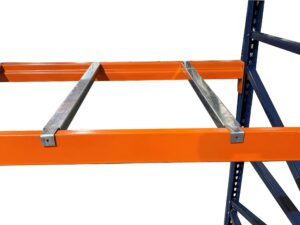
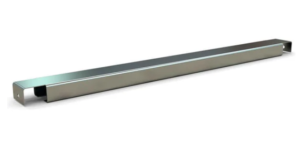
Flanged Cross Bar (occasionally referred to as “Lapped or Unlapped”)
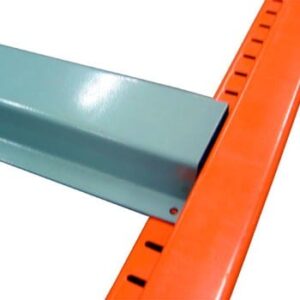
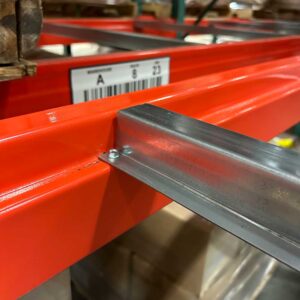
Unflanged Cross Bar (Flat top)
Available Depths: 36″, 42″, 48″
Flanged Cross Bars reduce the load on pallet rack beams by distributing weight more evenly. This added support enhances rack security, preventing rack failure and protecting both your products and personnel. Flanged Pallet Rack Cross Bars are flanged on both sides and made to fit into the 1 5/8″ deep step of a Pallet Rack cross Beam. Finish is either orange or galvanized,
*Note: We suggest the Cross Bars should be Tek screwed in the front and the back to secure them (and keep from moving) to the Pallet Rack Beams.
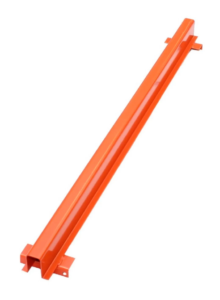
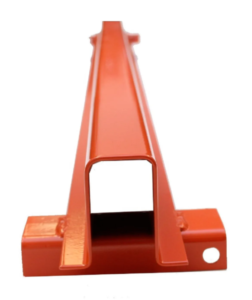
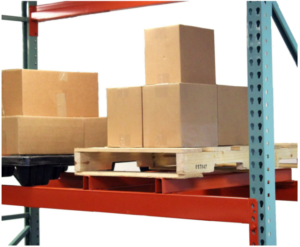
Pallet Rack Fork Clearance Bar (Fork Entry Bar)
Pallet Rack Fork Clearance Bars assist the forklift operator to properly position the load on the Rack. They are also extremely useful for products stored on oddly shaped skids (or no pallet at all) or product stored on only wood blocks. They can be used on traditional Teardrop Style (Roll Formed), or Structural Racking as well. These Entry Bars are TEK screwed to the Beam. The Interlake-Mecalux Fork Clearance or Entry Bars are positioned perpendicularly to the pallet rack beams, elevating the load by 2-1/2″ between the bottom of the load and above the beam’s level. They are 1.5″W.
Simply take two or more fork clearance bars and install them over a pair of pallet rack beams to create separation between load beams and load. The clearance will allow you to get under the load with the forks of your lift truck and safely lift the load from the rack.
Fork entry bars allow for easier and quicker picking of flat stock product from beams of a selective pallet rack system.
They come in several different depths, 36″D (1,680 lbs. capacity each) , 42″D (1,480 lbs. capacity each) and 48″D (1,230 lbs. capacity each) and each different depth has a different capacity. Heavier capacities are rarely an issue, simply include more Entry Bars for each load.
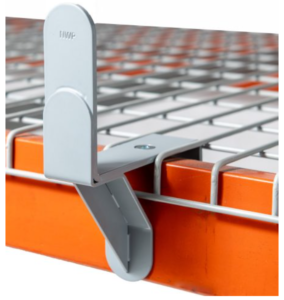
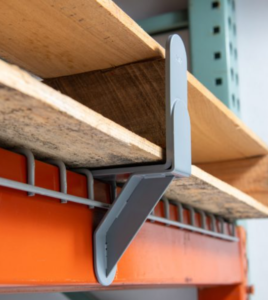
Pallet Stop
A simple and inexpensive device for preventing skids from falling off the back of Pallet Racks or allowing for the correct placement of the skid on the Racks. The Pallet Stop from Nashville Wire Company.
Originally designed to maintain optimal flue space and prevent skid displacement, these Pallet Stops are the perfect choice for ensuring compliance with fire safety regulations while improving operational safety and performance.
These Pallet Stops are engineered to integrate seamlessly with most Pallet Racking systems, ensuring reliable performance and long-lasting durability. Designed with safety in mind, they provide a secure barrier for pallets while maintaining critical flue spaces required for fire safety compliance.
KEY FEATURES OF THESE PALLET STOPS…
- Unmatched Fire Safety: Ensure precise flue space alignment and compliance with fire safety codes, reducing the risk of accidents caused by pallet displacement.
- Reliable Construction: Manufactured with high-grade materials and finished with a durable gray powder coat for long-lasting use in demanding environments.
- Ease of Integration: Compatible with most racking systems, these stops stops fit seamlessly without compromising efficiency.
- Universal Design: Designed for 2.75” deep beams to fit most applications.
- Easy Installation: Includes a sturdy Allen head Tek-screw for secure, simple mounting.
These units include a a built-in 3” offset and extend 5.24” above the Beam. They are in in-stock item and available for same or next day shipment!
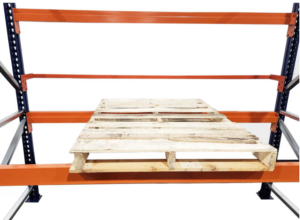
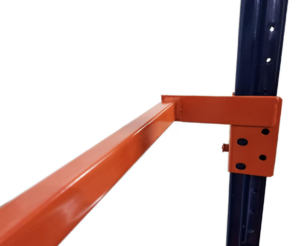
LOAD BACKSTOP BEAMS
Load Backstop Beams are the perfect solution to prevent pallets or skids from being pushed off the backside of the rack. They are also beneficial in positioning the pallet or skid perfectly on the Rack Beams (remember, the skid should hang over an inch or two on the front and an inch or two at the rear), this allows the load to be applied directly to the Beams, as they are designed to be loaded! These innovative Load Backstop Beams create a safer work environment… preventing improperly loaded pallets from potentially falling off racks and preventing a catastrophic workplace injury.
These Interlake-Mecalux Load Backstop Beams are a significantly less expensive option to the Load Stop Brackets (below). These unique Load Backstop Beams are a one-piece, all welded design and are ordered by Beam length. They closely resemble a standard Teardrop style Beam but are built in several different “offsets”, with 3” being the most common. They only come in one beam height, these Beams are designed to prevent improper pallet placement, they do not support any type of weight.
One other note… these Load Backstop Beams are super easy to install… they are as easy to install as installing a single Pallet Rack Beam-no tools required!
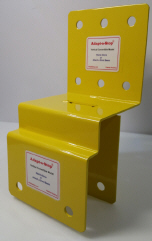
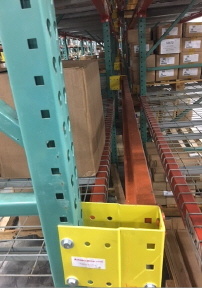
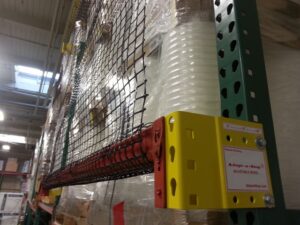
Pallet Rack Stop Beams (Adapt-A-Stop)
Pallet Rack Load Stops easily cover the length of several bays, adapting to a variety of bay sizes, using standard pallet rack horizontal load beams, strut channel, or slotted vertical beams. Food storage warehouses will greatly benefit from having aligned pallets since complying with rodent trap placement regulations is made easier. Pallets stay in the bay, standardizing clearances from walls and other items nearby and complying with fire code regulations for maintaining longitudinal flue spaces.
Pallet Rack Load Stop connection brackets protect & help comply with…
- Protect warehouses, facilities, & stored product from forklift or pallet jack damage.
- Make aligning pallets in bays easier by providing a sturdy guide.
- Regulate space between pallets & walls or aisles.
- Guarantee rodent trap space along walls; fulfilling food storage regulations.
- Comply with building & fire code ordinances ensuring required flue space
- Improve warehouse safety by keeping product from falling off racks.


Steel Shims for Uneven Surfaces
Steel Shims can be provided to install Pallet Rack Uprights on uneven surfaces. It is imperative that Pallet Racking be installed on flat or level surfaces. In applications where the concrete is old, cracked or uneven, steel shims can be installed to help level the base.
Shims come in a range of different styles. It is important that you pick the correct pallet rack shim plate to match the brand of upright and size of the footplate. Upright footplates can vary in design, as a result, it is very important to use only factory approved shims, as the are specifically sourced based off of the design of the Uprights.
Depending on the severity of the base, there may be a need to use more than one shim. If that is the case, there are very specific guidelines to follow as to how many are safe and how to secure them in place to prevent shifting.
- Shim stack cannot exceed six times the diameter of the largest anchor bolt.
- Shim stack that is less than two times the anchor’s diameter does not require locking shims together by welding or installing a second anchor.
- Shim stacks between two times but less than six times the diameter of the anchor must be locked by welding or adding a second anchor. If shims are not welded or secured with a second anchor, they can spin out, causing rack instability.
- Shim stacks may require longer anchor bolts.
Most Pallet Rack accessories are in-stock and can be shipped with any order and include…
We welcome you to visit, browse or shop our online catalog.
Search by item, product ID or category. Also, see featured products.
